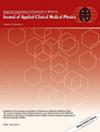Quantification of dose accumulation using deformable image registration: Application in re-irradiation of liver metastases using robotic radiosurgery
Abstract
Purpose
This study evaluates cumulative dose estimations using deformable image registration (DIR) in robotic stereotactic ablative radiotherapy (SABR)-based multiple re-irradiations for liver metastases. It highlights DIR's role and accuracy in adaptive radiotherapy to enhance treatment precision and reduce toxicity.
Materials & Methods
A retrospective analysis was conducted on 22 patients (age: 42–80, median: 61 years) with liver metastases re-irradiated using CyberKnife SABR (54 treatments) between June 2016 and February 2024. A comparative analysis of organs-at-risk (OAR) volumes was performed using contours derived from DIR and physical summation method to evaluate consistency between the two approaches. Dosimetric analysis involved accumulating doses to organs at risk using physical dose summation and DIR-based dose summation. To standardize dose assessments, all radiation doses were converted into equivalent doses in 2 Gy fractions (EQD2) and biologically effective doses (BED). The DIR algorithm was quantitatively assessed using similarity indices, including Dice similarity coefficient (DSC) and Jaccard (JD) index.
Results
The findings demonstrated that organs susceptible to motion, such as the liver and large bowel, exhibited greater variability in volume measurements when evaluated using physical summation. A significant reduction in maximum dose for the liver (p = 0.00) and chest wall (p = 0.05) was observed under DIR-based dose accumulation (liver-83.2 ± 28.0 Gy; chest wall-66.9 ± 18.6 Gy) compared to physical summation (liver-123.8 ± 55.6 Gy; chest wall-82.9 ± 22.4 Gy), suggesting overestimation using physical summation. Among the analyzed structures, DIR showed high spatial accuracy for the heart, liver, and external body with Dice scores > 0.90 and Jaccard indices > 0.84, while lower agreement was noted for deformable organs such as the bowel with Dice scores < 0.43 and Jaccard indices < 0.29.
Conclusions
DIR improved anatomical alignment and provides more anatomically consistent cumulative dose estimation in SABR re-irradiation, particularly for OARs that are prone to deform. Integrating DIR into adaptive radiotherapy workflows can improve the estimation of dose to OARs while minimizing toxicity risks.


 求助内容:
求助内容: 应助结果提醒方式:
应助结果提醒方式:


